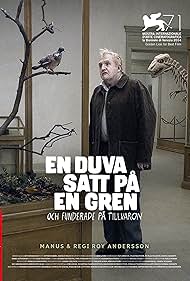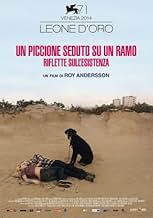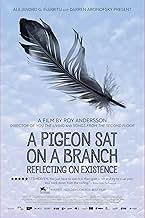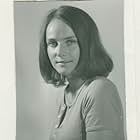A Pigeon Sat on a Branch Reflecting on Existence
Original title: En duva satt på en gren och funderade på tillvaron
IMDb RATING
6.9/10
20K
YOUR RATING
Sam and Jonathan, a pair of hapless novelty salesmen, embark on a tour of the human condition in reality and fantasy that unfold in a series of absurdist episodes.Sam and Jonathan, a pair of hapless novelty salesmen, embark on a tour of the human condition in reality and fantasy that unfold in a series of absurdist episodes.Sam and Jonathan, a pair of hapless novelty salesmen, embark on a tour of the human condition in reality and fantasy that unfold in a series of absurdist episodes.
- Awards
- 5 wins & 28 nominations
- Director
- Writer
- All cast & crew
- Production, box office & more at IMDbPro
Storyline
Did you know
- TriviaThe title was inspired by the painting The Hunters in the Snow by Pieter Bruegel the Elder.
- ConnectionsFollows Songs from the Second Floor (2000)
- SoundtracksShimmy Doll
Performed by Ashley Beaumont
Featured review
Pigeon is made in the same style as You, the Living. Again we have plenty of short scenes, shot from one angle, with no cuts. Filled with absurdity, no actual plot, various way of interpretation. Too deep or too obvious, Andersson bounces between two extremes. The characters and the scenes are overdrawn. Everything happens in one, slow pace. Silence is boring and dulling the vigilance. In comparison, You, the Living seemed more... lively.
If Andersson shows Swedish society, I felt the criticism towards it in one scene, mocking it in the second and a direct reference to it in the third. The critique is present in a scene with elderly elegant Swedes observing the cruelty, done by non-Sweden. For me this is a reflection on Swedish neutrality in the 20th century. Mocking the Swedish society appears in the last scene. Bunch of people is waiting at the bus stop and one of the men starts to ask if today it's really Wednesday, cause for him it felt like Thursday. The group assures him that yes indeed, it's Wednesday. Additionally, the other man explains, that we all have to agree that it's Wednesday, otherwise there's gonna be chaos. Of course the first man did not imply that we wished it's another day of the week or that he is still gonna pretend it's not Wednesday. It did not hinder the other man to make sure that everything is clear - even if you feel like something else, you have to agree with everyone else in order to keep peace and organization. It might be exaggerated reference to Jantelagen (no one is special, no one should act like they are superior to one another). It is established that it's Wednesday, everyone has to adjust.
And then it's my favourite scene with Charles XII. He, as a Swedish king, should be a clear indicator that Andersson tells something about Sweden. Okay, we have a king with absolute power, everyone serves him even if he has the most ridiculous demands. But... this could be any monarch, right? So for me by using him, the director was more about praising the modernization, understood both as moving from kingdoms to democracy and as equalization of the societies. Choosing Charles XII could simply just give Andersson space to mock king's homosexual needs, which was directly shown. Despite different possible interpretations, I admire Andersson for the technical management of this scene. It's the longest one in the movie and the most complicated. So many elements could go wrong and in the end there is this final version with no cut. Standing ovation.
What if we look at Pigeon not as a portrait of Swedish life, but a life itself? All the feelings are phlegmatic. Even love, even anger, even laughter. Is the life so unfair or do we make it this way ourselves? I think that Swedish societ" is just a frame. Andersson is using some obvious cliches and stereotypes (which still can be true!) about his motherland in order to explain something more, something common to all human beings. Or I'm just trying to find deeper meaning which really isn't there. If so, this is just another proof of this director's strength - his movies can be seen through so many shades of interpretation.
If Andersson shows Swedish society, I felt the criticism towards it in one scene, mocking it in the second and a direct reference to it in the third. The critique is present in a scene with elderly elegant Swedes observing the cruelty, done by non-Sweden. For me this is a reflection on Swedish neutrality in the 20th century. Mocking the Swedish society appears in the last scene. Bunch of people is waiting at the bus stop and one of the men starts to ask if today it's really Wednesday, cause for him it felt like Thursday. The group assures him that yes indeed, it's Wednesday. Additionally, the other man explains, that we all have to agree that it's Wednesday, otherwise there's gonna be chaos. Of course the first man did not imply that we wished it's another day of the week or that he is still gonna pretend it's not Wednesday. It did not hinder the other man to make sure that everything is clear - even if you feel like something else, you have to agree with everyone else in order to keep peace and organization. It might be exaggerated reference to Jantelagen (no one is special, no one should act like they are superior to one another). It is established that it's Wednesday, everyone has to adjust.
And then it's my favourite scene with Charles XII. He, as a Swedish king, should be a clear indicator that Andersson tells something about Sweden. Okay, we have a king with absolute power, everyone serves him even if he has the most ridiculous demands. But... this could be any monarch, right? So for me by using him, the director was more about praising the modernization, understood both as moving from kingdoms to democracy and as equalization of the societies. Choosing Charles XII could simply just give Andersson space to mock king's homosexual needs, which was directly shown. Despite different possible interpretations, I admire Andersson for the technical management of this scene. It's the longest one in the movie and the most complicated. So many elements could go wrong and in the end there is this final version with no cut. Standing ovation.
What if we look at Pigeon not as a portrait of Swedish life, but a life itself? All the feelings are phlegmatic. Even love, even anger, even laughter. Is the life so unfair or do we make it this way ourselves? I think that Swedish societ" is just a frame. Andersson is using some obvious cliches and stereotypes (which still can be true!) about his motherland in order to explain something more, something common to all human beings. Or I'm just trying to find deeper meaning which really isn't there. If so, this is just another proof of this director's strength - his movies can be seen through so many shades of interpretation.
- magda_butra
- Jan 17, 2018
- Permalink
- How long is A Pigeon Sat on a Branch Reflecting on Existence?Powered by Alexa
Details
- Release date
- Countries of origin
- Official site
- Languages
- Also known as
- İnsanları Seyreden Güvercin
- Filming locations
- Production companies
- See more company credits at IMDbPro
Box office
- Gross US & Canada
- $222,989
- Opening weekend US & Canada
- $25,313
- Jun 7, 2015
- Gross worldwide
- $1,421,411
- Runtime1 hour 41 minutes
- Color
- Aspect ratio
- 1.78 : 1
Contribute to this page
Suggest an edit or add missing content

Top Gap
By what name was A Pigeon Sat on a Branch Reflecting on Existence (2014) officially released in India in Hindi?
Answer












